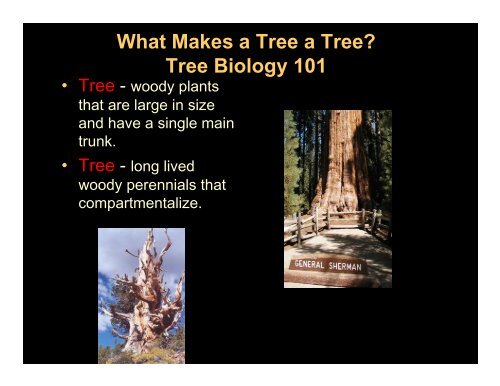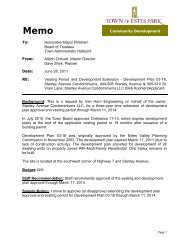What Makes a Tree a Tree? Tree Biology 101 - Up
What Makes a Tree a Tree? Tree Biology 101 - Up
What Makes a Tree a Tree? Tree Biology 101 - Up
Create successful ePaper yourself
Turn your PDF publications into a flip-book with our unique Google optimized e-Paper software.
<strong>What</strong> <strong>Makes</strong> a <strong>Tree</strong> a <strong>Tree</strong><br />
<strong>Tree</strong> <strong>Biology</strong> <strong>101</strong><br />
• <strong>Tree</strong> - woody plants<br />
that are large in size<br />
and have a single main<br />
trunk.<br />
• <strong>Tree</strong> - long lived<br />
woody perennials that<br />
compartmentalize.
<strong>Tree</strong>s are different from<br />
other plants because…<br />
If conditions remain<br />
favorable, they can live<br />
for a very long time
Let’s look at<br />
a tree and<br />
how it might<br />
grow over<br />
time….here’s<br />
how many<br />
seedlings<br />
look shortly<br />
after they<br />
sprout…..
In a few<br />
years……
….at about 10<br />
years or so
…perhaps<br />
in 30 to 40<br />
years
<strong>Tree</strong>s are genetically “wired”<br />
to live for a long time…..This<br />
tree is over 130 Years Old...
The Wye Oak (a white oak) was estimated<br />
to be over 460 years old before it fell…
This is what<br />
a 1700 year<br />
old tree<br />
looks like
This one is over<br />
2,300 years old!
275 ft tall<br />
33 feet in<br />
diameter, that<br />
is 103 ft in<br />
circumference
How Old Is The Oldest Living Thing On Earth<br />
“Methuselah” A Bristlecone Pine<br />
4,777<br />
YEARS<br />
OLD!!!!
<strong>What</strong> <strong>Makes</strong> A <strong>Tree</strong> A <strong>Tree</strong><br />
• <strong>Tree</strong> <strong>Biology</strong> - the study of structure and<br />
function, and the relationship between<br />
them<br />
– Anatomy - the study of the component<br />
parts of the tree<br />
– Physiology - the study of the biological and<br />
chemical processes within these<br />
components
Basic <strong>Tree</strong> Anatomy<br />
• All living organisms are made up of<br />
cells, tissues and organs<br />
• New cells form from the division of<br />
existing cells<br />
• In trees, these areas of cell division are<br />
called meristems
<strong>Tree</strong> Anatomy-Cells and<br />
Tissues continued<br />
• Apical Meristems - primary meristems that<br />
produce cells that result in elongation of<br />
roots and shoots<br />
• Lateral Meristems - secondary meristems<br />
that produce cells that result in an increase<br />
in diameter<br />
– Cambium - a lateral meristem that is a thin,<br />
continuous sheath of cells that divide to produce<br />
the vascular system of the tree:<br />
• Xylem – woody tissue, movement of water<br />
• Phloem – movement of food
Leaves
<strong>Tree</strong> Anatomy – Deciduous vs<br />
Evergreens<br />
• Evergreen <strong>Tree</strong>s – hold leaves for<br />
more than 1 year<br />
• Deciduous <strong>Tree</strong>s – shed leaves every<br />
year<br />
– Forms an Abscission Zone (A Z)<br />
• The A Z is formed as a result of changes in<br />
cells and growth regulators as temperatures<br />
drop and nights get longer in the Fall<br />
• A Z forms at the base of a leaf stem or<br />
“petiole” every year
<strong>Tree</strong> Anatomy-Leaves<br />
• Making Food is the Primary Function of<br />
Leaves! (Photosynthesis)<br />
– CO2 + H2O + Light Energy = Carbohydrates (Sugars) + O2<br />
– Occurs in:<br />
• Chlorophyll– green photo-reactive<br />
pigment found in the chloroplasts<br />
• Chloroplasts – specialized organelles<br />
found in plant cells that are the site of<br />
photosynthesis
From micro.magnet.fsu.edu
From ISA Introduction to Arboriculture <strong>Tree</strong> <strong>Biology</strong> CD
Stems
<strong>Tree</strong> Anatomy – Woody Section<br />
Earlywood - xylem produced in Spring<br />
Latewood - xylem produced later in Summer<br />
Growth Ring – visible rings created by the<br />
combination of early and latewood<br />
Ray cells – live parenchyma cells that transport<br />
sugars and other compounds through the trunk<br />
radially
Physiology -<br />
Compartmentalization<br />
• CODIT- Compartmentalization Of Decay In<br />
<strong>Tree</strong>s<br />
-Wall 1-resists vertical spread of decayxylem<br />
plugging (weakest wall)<br />
-Wall 2-resists inward spread of decaycompact<br />
latewood cells<br />
-Wall 3-resists lateral spread - ray cells<br />
-Wall 4-resists outward spread into new<br />
wood that is formed –(strongest<br />
wall)
From ISA Introduction to Arboriculture<br />
<strong>Tree</strong> <strong>Biology</strong> CD
Xylem continued<br />
• Ring Porous Wood – form wide vessels early<br />
in the growing season and narrower ones<br />
later<br />
– Elms<br />
– Oaks<br />
– Ash<br />
• Diffuse Porous Wood – form uniform sized<br />
vessels throughout growing season<br />
– Maples<br />
– Sycamore<br />
– Populus
Diffuse<br />
Porous Wood<br />
Ring Porous<br />
Wood<br />
University of Toronto<br />
University of Texas
<strong>Tree</strong> Anatomy - Phloem<br />
• Phloem – made up mostly of living cells<br />
– Responsible for the transport of food within the<br />
tree (sugars = photsynthates)<br />
• Transport occurs along a gradient<br />
• Transport requires energy<br />
– Comprised of:<br />
• Sieve Cells in conifers<br />
• Sieve Tube Elements and Companion Cells in<br />
hardwoods<br />
– As a tree grows, old phloem is crushed and may be<br />
absorbed into the tree or incorporated into the bark
<strong>Tree</strong> Anatomy - Bark<br />
• Bark - outer covering of a tree’s<br />
branches and stems composed of<br />
non-functional phloem and corky<br />
tissue that:<br />
-moderates temperature<br />
-offers some defense against injury<br />
-reduces water loss<br />
• Lenticels - small openings in bark<br />
that allow for gas exchange
Lenticels in Cherry Bark
<strong>Tree</strong> Anatomy - Stems<br />
• Hierarchy of stem composition:<br />
– Trunks support branches<br />
– Branches support other branches or twigs<br />
– Twigs support leaves, flowers and fruit<br />
• Buds occur:<br />
– At the tip of each twig (terminal or apical buds)<br />
– Along the twig (lateral or axillary buds)<br />
– At the base of each leaf ( flower and leaf buds)<br />
– Just under the bark (adventitious buds)<br />
• Dormant until released<br />
• When released they give rise to epicormic shoots
<strong>Tree</strong> Anatomy-Branches<br />
• Branches - are autonomous and usually<br />
produce and store enough carbohydrates to<br />
sustain themselves<br />
• Branch Collar-shoulder area where a branch<br />
joins another branch or trunk created by the<br />
overlapping xylem tissues<br />
– Strong attachment on bottom of branch to the parent stem<br />
– Weaker attachment on the top<br />
• Branch Bark Ridge-area of a branch union<br />
where the growth and development of the two<br />
adjoining limbs push the bark into a ridge<br />
• Included Bark-bark that is pushed inside a<br />
developing branch union, causing a<br />
weakened structure
From ISA Arborists’<br />
Certification Study<br />
Guide, Figure 8.2,<br />
1 st edition
From ISA Arborists’ Certification<br />
Study Guide, Figure 8.3, 1st edition<br />
From ISA<br />
Arborists’<br />
Certification<br />
Study Guide,<br />
Figure 8.5, 1 st<br />
edition
Roots
Mycorrhizae – the symbiotic association<br />
consisting of fungi and roots
Critical Root Zone
Physiology – Water Movement<br />
• Water is used for:<br />
– Maintaining cell turbidity<br />
– Transport of essential elements<br />
– Growth and Metabolism<br />
• Most of a trees water is lost through<br />
Transpiration<br />
• Pathway of water into roots = Osmosis:<br />
– Water goes from area of high water potential to<br />
area of low potential<br />
– Usually moves into roots from the soil, but can<br />
move out of roots into soil if potential is lower in<br />
the soil
<strong>Tree</strong> Physiology<br />
• Transpiration:<br />
– It is the loss of water vapor through the<br />
stomata<br />
– Cools leaves<br />
– Creates “transpirational pull”<br />
– Temperature, humidity & available water<br />
affect rates
The Cultivation<br />
of <strong>Tree</strong>s<br />
is the<br />
Cultivation of<br />
the Good…
…the<br />
Beautiful…
…and the Ennobling<br />
in Man…<br />
- J. Sterling Morton
QUESTIONS
WE NEED TO PLANT THE RIGHT<br />
TREE IN THE RIGHT PLACE!!!
We Cannot Control The<br />
Weather
<strong>Tree</strong> Physiology –<br />
The Vascular System<br />
• Phloem Transport:<br />
– Movement of photosynthate in the phloem<br />
• From areas of high sugar concentration to areas of lower sugar<br />
concentrations<br />
• Requires energy<br />
– Source - leaves, areas of high sugar concentration<br />
– Sink - plant parts that use more energy than they produce<br />
• Most plant parts can be sinks at some point in their life<br />
• Phloem transport occurs from leaves to roots, but most<br />
photosynthate is either used or stored in close proximity to where it<br />
is created<br />
• Radial Transport - horizontal movement of water and<br />
nutrients primarily through ray cells
From ISA<br />
Arborists<br />
Certification<br />
Study Guide,<br />
Figure 1.12, 1 st<br />
edition
Physiology – Growth Regulators<br />
• Growth & Development are results of the<br />
interaction of a tree’s genetic potential and<br />
the environmental conditions where it is<br />
growing<br />
– Plant Growth Regulators:<br />
• Naturally occurring substances that act to<br />
regulate plant growth and development<br />
• It only takes small quantities to affect growth<br />
• Classified as plant hormones:<br />
– Auxins<br />
– Cytokinins<br />
– Gibberellins<br />
– Abscisic acid<br />
– Ethylene
Physiology – Growth Regulators<br />
• Auxins<br />
– Produced primarily in shoot tips, but may be produced at other sites<br />
of cell division<br />
– Instrumental in root development<br />
– Involved with “tropisms”<br />
• Geotropism<br />
• Phototropism<br />
• Cytokinins<br />
– Produced primarily in the roots<br />
– Instrumental in shoot initiation and growth<br />
• Gibberellin<br />
– Growth regulator involved in cell elongation<br />
• Abscissic Acid<br />
– Plant growth substance that triggers leaf or fruit drop<br />
• Ethylene (gas)<br />
– Naturally occurring growth substance that triggers fruit ripening
Physiology – Growth Regulators<br />
• <strong>Tree</strong> form can be strongly directed by<br />
growth regulators<br />
– Decurrent tree form (rounded crown form)<br />
• Result of new lateral shoots outgrowing the original<br />
terminal shoot year after year<br />
• Indicates weak apical control<br />
– Excurrent tree form (upright crown form)<br />
• Results from strong apical control so that terminal shoot<br />
remains dominant as lateral shoots form<br />
• Most juvenile trees start out with excurrent form
Excurrent Habit<br />
Decurrent Habit<br />
from urbantree.org








